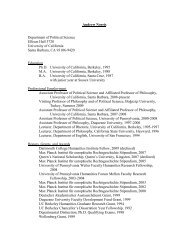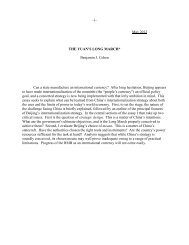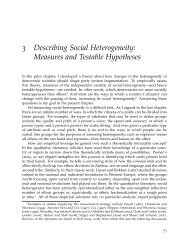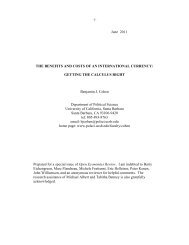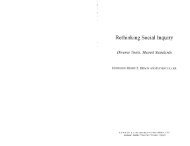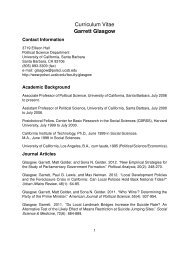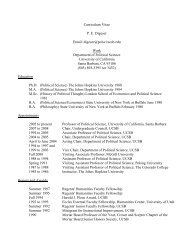Are Niche Parties Fundamentally Different from Mainstream Parties ...
Are Niche Parties Fundamentally Different from Mainstream Parties ...
Are Niche Parties Fundamentally Different from Mainstream Parties ...
Create successful ePaper yourself
Turn your PDF publications into a flip-book with our unique Google optimized e-Paper software.
518 JAMES ADAMS, MICHAEL CLARK, LAWRENCE EZROW, AND GARRETT GLASGOW<br />
to shift their party’s policies in the opposite direction <strong>from</strong><br />
their shifts in previous elections. Budge, who argues that<br />
party elites may pursue this strategy of “policy alternation”<br />
because they recognize the need to satisfy both the<br />
moderate and the radical wings of their parties, finds empirical<br />
support for the alternation hypothesis in his analysis<br />
of CMP data <strong>from</strong> 20 postwar democracies. Adams,<br />
meanwhile, develops a spatial model in which voters are<br />
moved by a combination of policy distance and nonpolicy<br />
considerations and concludes that voters’ nonpolicyrelated<br />
attachments (such as party identification) can give<br />
political parties electoral incentives to shift their policies<br />
back and forth over time, thereby creating a pattern that<br />
resembles Budge’s alternation model. 7 Failure to control<br />
for any tendency of parties to shift their policy positions<br />
in this way could make some parties appear more or less<br />
responsive to shifts in public opinion than they actually<br />
are. Thus, we include a lagged measure of a party’s policy<br />
shift (the shift <strong>from</strong> election (t − 2) to election (t − 1)),<br />
which we label previous policy shift.<br />
In a similar vein, past work has hypothesized that<br />
parties shift their policy positions in the same direction<br />
as their previous policy shift if they gained vote share in<br />
the previous election and in the opposite direction if they<br />
lost votes in the previous election. Budge (1994) argues<br />
that party elites may shift their policies in this way because<br />
they view past election results as the only clear electoral<br />
signal as to the effectiveness of their policy positions, while<br />
Adams et al. (2004) posit that these types of shifts could<br />
result <strong>from</strong> party leadership changes after unfavorable<br />
election outcomes (see also Andrews and Jackman 2005).<br />
Again, failure to control for any tendency of parties to shift<br />
their policy positions in response to past election results<br />
could produce misleading estimates of party responsiveness<br />
to public opinion. Thus, we include a measure of a<br />
party’s change in vote share in the previous election—<br />
namely, the difference between the party’s vote share at<br />
7 We note that there are two additional considerations that motivate<br />
our decision to control for parties’ previous policy shifts. First, Burt<br />
(1997) points out that a pattern of policy alternation can be generated<br />
by a model in which, at each election, each party’s policies<br />
are generated <strong>from</strong> a random probability distribution centered on<br />
some central tendency that is constant across elections and is specific<br />
to that party. Burt’s model plausibly captures the dynamics of<br />
intraparty policy disputes in which, at each successive election, activists<br />
representing opposing policy views within the party compete<br />
to determine the party’s policy direction. Second, we note that even<br />
if parties’ “true” policy positions are stable over time, to the extent<br />
that the CMP’s estimates of these positions contain measurement<br />
error, such errors can generate patterns similar to those produced<br />
by Burt’s model. To the extent that any of these processes—Budge’s<br />
and Adams’s alternation models, Burt’s random ideologies model,<br />
or measurement error—influence parties’ observed policy dynamics<br />
as measured <strong>from</strong> the CMP’s codings, failure to control for<br />
parties’ past policy shifts may produce misleading inferences.<br />
election t − 1 and its vote share at election t − 2—which<br />
we label previous change in vote share, and the interaction<br />
between this measure and previous policy shift. This variable<br />
is constructed so that a positive coefficient estimate<br />
implies that parties respond to past election results by<br />
shifting their policy positions in the same direction as the<br />
last time if they gained votes in the previous election, and<br />
in the opposite direction if their vote shares declined. Finally,<br />
we include dummy variables for each country in our<br />
data, which allows us to control for institutional effects or<br />
other country-specific factors that could influence party<br />
policy shifts.<br />
Evaluating the Policy Stability Hypothesis<br />
Our analysis encompassed 158 policy shifts by voters and<br />
parties in Britain, Italy, Denmark, France, Greece, Spain,<br />
Luxembourg, and the Netherlands, over 36 elections in the<br />
period 1976–98; the complete set of parties included in the<br />
analysis is reported in the appendix. Note that pooling our<br />
data across countries entails the assumptions that the data<br />
is comparable cross-nationally and that the same causal<br />
processes operate in each country. The sensitivity analyses<br />
we report below support these assumptions.<br />
Our data contains 37 parties, each observed over an<br />
average of 4.3 elections, and should thus be regarded<br />
as time-series cross-sectional (TSCS) data. Estimating a<br />
simple regression on the pooled data can lead to erroneous<br />
conclusions if there are unobserved differences between<br />
parties (Hsiao 2003; Green, Kim, and Yoon 2001)—<br />
fortunately, tests for party-specific effects indicate that<br />
this is not a concern for the model we specify to examine<br />
the Policy Stability Hypothesis. 8 However, there are other<br />
methodological concerns to address. The “policy alternation”<br />
findings that emerge <strong>from</strong> the work of Budge<br />
(1994) and Adams (2001) suggest that serially correlated<br />
errors may be a problem. The lagged dependent variable<br />
included in our specification helps to address this concern<br />
(Beck and Katz 1995, 1996), and a Lagrange multiplier<br />
test fails to reject the null hypothesis of no serial correlation.<br />
Another concern is that there may be unobserved<br />
election-specific factors that influence all parties’ policy<br />
shifts in a particular election, leading to correlated errors<br />
among the parties competing in a particular election. We<br />
address this concern through the use of robust standard<br />
errors clustered by election (Rogers 1993; Williams 2000).<br />
Table 1 reports the parameter estimates for our test of the<br />
Policy Stability Hypothesis.<br />
8 An F-test for fixed-effects (F 36,116 = 0.36, p = 1.00) and a likelihood<br />
ratio test for random effects (x 2 1<br />
= 0.00, p = 1.00) both failed to<br />
reject the null hypothesis of no party-specific effects.


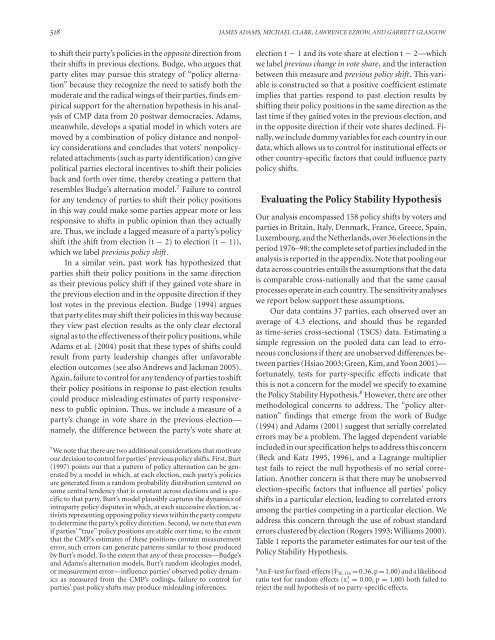

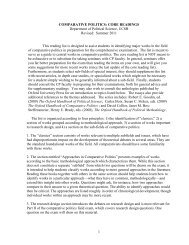
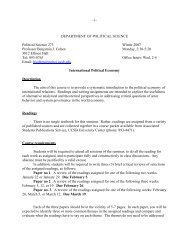

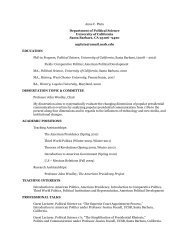
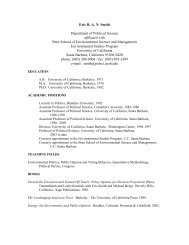
![Curriculum Vitae [abbreviated] John T. Woolley Professor of Political ...](https://img.yumpu.com/25423597/1/190x245/curriculum-vitae-abbreviated-john-t-woolley-professor-of-political-.jpg?quality=85)
